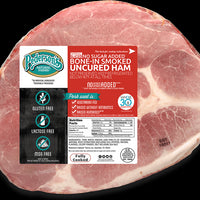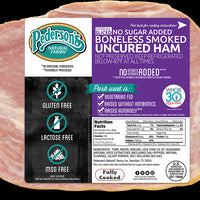Cured and uncured ham are both popular choices when it comes to selecting a flavorful and versatile type of meat. In this article, we will dig into the differences between the two, weigh their pros and cons, and help you make an informed decision about which one is best suited for your needs.
Ham is essentially a leg of pork, and the distinction between cured and uncured ham lies in the preservation process. Cured ham is processed and preserved through wet or dry curing, which may include smoking and adding a combination of sugar, salt, and other flavors.
This process lends a pink or deep rose color to the meat and imparts a salty flavor. On the other hand, uncured ham refers to fresh, unpreserved pork, and typically does not undergo the same level of processing.
As we discuss cured vs uncured ham, it's important to consider not only their differences in taste and appearance, but also their impact on our overall well-being. While cured ham contains artificial compounds, uncured ham uses only natural sources of nitrites.
Regardless of whether it is chemically or naturally preserved, the objective remains the same: providing a safe and enjoyable eating experience. As consumers, it's crucial to know the meat we choose and understand the factors that shape our preferences.
Understanding Ham
Ham is a popular meat choice derived from pork and is known for its unique flavor and versatility in various dishes. Depending on the method of preservation, there are two main types of ham: cured and uncured.
Cured ham is processed and preserved through wet or dry curing that may include smoking. This process involves the addition of sugar, salt, and other flavors, resulting in a pink or deep rose color.
On the other hand, uncured ham, despite its name, does undergo a curing process to preserve it. However, it is cured naturally without synthetic nitrates and may take days or even weeks to cure. Instead, it is treated with a brine made of natural ingredients.
Both cured and uncured hams are sourced from the leg of a pig, which means they have a similar texture and overall taste. They can both be cooked using similar methods such as baking, roasting, or grilling, allowing cooks to achieve a variety of delicious flavors.
Cured Ham Explained
Cured ham is a type of preserved pork that undergoes a curing process, which involves treating the meat with a combination of salt, nitrates, and other flavorings. This method helps to preserve the meat, giving it a longer shelf life and preventing spoilage. The predominant ingredient used in the curing process is salt, while nitrates or sodium nitrite are also used to further protect the meat from bacteria and improve its color.
Curing can be done through a wet or dry method. In wet-curing, the ham is soaked in a brine solution, which often contains spices, brown sugar, and synthetic nitrates. Alternatively, in the dry-cure method, the ham is rubbed with a mixture of salt, spices, and sodium nitrite, and then left to age at room temperature. Both methods contribute to the meat's distinct smoky flavor, firm texture, and pink color. Additionally, cured ham may be smoked for added flavor and preservation.
It is important to note that cured ham is different from bacon, which undergoes a similar but distinct process involving different cuts of pork. Bacon is typically dry-cured, whereas ham can be either wet or dry-cured.
Though cured ham is a beloved food item for many, some concerns have been raised over the use of synthetic nitrates and artificial preservatives in the curing process. Nitrates have been linked to potential carcinogen risks when consumed in large quantities.
As a result, some have opted for natural alternatives such as celery powder, which contains naturally occurring nitrates and is used in place of synthetic ones.
Uncured Ham Defined
Uncured ham is a type of pork that hasn't been preserved through traditional curing methods, such as the addition of salt, sugar, and nitrates. Instead, this meat undergoes a more natural curing process that involves using ingredients like sea salt and celery powder, which are rich in natural nitrites. Due to the absence of synthetic nitrates, the color of uncured ham is usually lighter than that of cured ham, and it may have a slightly different flavor profile.
The curing process of uncured ham typically involves a wet brine. This brine helps to preserve the meat and enhance its flavor. In some cases, celery powder or beet extracts, both of which contain natural nitrates, may also be added to aid in preservation. The meat can be prepared by methods such as smoking and baking to give it a distinct taste and texture.
When it comes to selecting the best uncured ham for purchase, looking for products like the Spiral Sliced No Sugar Added Boneless Smoked Uncured Ham and Spiral Sliced No Sugar Added Bone-In Smoked Uncured Ham can be a good choice, as they are made using ethical and eco-friendly practices, without the addition of artificial ingredients or preservatives, and are suitable for whole-food, paleo, and keto diets.
Cured vs Uncured Ham: The Main Differences
Cured ham and uncured ham are two popular types of pork meat with differing preparation methods and characteristics. The main difference between them lies in the preservation process.
Cured ham is processed ham that is preserved through wet or dry curing, which may include smoking and the addition of sugar, salt, and other flavors. This process results in a pink or deep rose color.
In contrast, uncured ham is an unpreserved leg of pork, though it still undergoes a type of curing process. Instead of using synthetic nitrates, uncured ham is soaked in a brine made with natural ingredients, such as celery or beet extract, before being smoked or cooked.
A significant factor that sets these two types of ham apart is the use of nitrates and nitrites. Cured ham often contains sodium nitrite as a preservative to prevent bacterial growth and maintain color. On the other hand, uncured ham uses natural preservatives in place of synthetic nitrates, providing similar protection against spoilage without the use of artificial additives.
When it comes to flavors, cured ham has a salty and smoky taste due to the brining and smoking processes. In comparison, uncured ham may also possess a smoky flavor, but it generally retains more of the natural pork taste.
Health Implications
To reiterate what we’ve been discussing, cured and uncured ham have different health implications due to their methods of preservation. Cured ham is processed with the use of salt, sodium nitrite, and other chemicals, while uncured ham is preserved with natural ingredients and methods, like salt, black pepper, celery powder, and spices.
Cured ham often contains nitrates, which can be harmful to human health as they can form carcinogenic nitrosamine compounds when ingested. As a result, consuming large amounts of processed meats like cured ham and bacon might increase the risk of certain types of cancer. Sodium nitrite, which is often used as a preservative in cured ham, is also associated with a higher risk of developing cancer.
In contrast, uncured ham is considered to be a healthier option, as it has a lower sodium content and doesn't contain the same chemicals as cured ham. Lower sodium intake is beneficial for those who need to watch their blood pressure or are at risk of heart disease. However, it's vital to maintain moderation in consumption, as excessive intake may still pose health risks.
Frequently Asked Questions
What are the health benefits of uncured ham?
Uncured ham offers health benefits as it avoids additives that are commonly used in the curing process. These additives include sodium nitrite, sodium acetates, sodium diacetate, and sodium erythorbate. Since uncured ham does not have these additives, it is considered a more natural and potentially healthier option. Moreover, uncured ham is not treated with salt or sugar so it may have lower sodium and sugar content which is beneficial for those following a specific diet.
How long can you store uncured ham?
Storage duration depends on factors like the packaging, temperature, and handling. Generally, it should be refrigerated and consumed within 3-5 days of opening. If you freeze the uncured ham, it can extend the shelf life to a few months but be sure to follow proper freezing protocols.
Are there risks associated with eating cured ham?
Certain risks can be associated with consuming cured ham in excess as it often contains additives and preservatives which may pose health concerns. The use of sodium nitrite, for example, has been linked to potential risks, including increased cancer risk when consumed in large amounts. Moreover, the salt and sugar content in cured ham may not be suitable for those with specific dietary restrictions or health concerns.




